The old days
Before the industrial revolution, our energy needs were modest. For heat, we relied on the sun—and burned wood, straw, and dried dung when the sun failed us. For transportation, the muscle of horses and the power of the wind in our sails took us to every corner of the world. For work, we used animals to do jobs that we couldn't do with our own labor. Water and wind drove the simple machines that ground our grain and pumped our water.
Simple machines based on the ability to harness the power of steam have been dated by some sources as far back as ancient Alexandria. The evolution of the steam engine continued over time and significantly ramped up in the 17th and 18th centuries. But it was the significant adaptations of Thomas Newcomen and James Watt in the mid 1700s that gave birth to the modern steam engine, opening up a world of possibility. A single steam engine, powered by coal dug from the mines of England and Appalachia, could do the work of dozens of horses.
More convenient than wind and water, and less expensive than a stable full of horses, steam engines were soon powering locomotives, factories, and farm implements. Coal was also used for heating buildings and smelting iron into steel. In 1880, coal powered a steam engine attached to the world's first electric generator. Thomas Edison's plant in New York City provided the first electric light to Wall Street financiers and the New York Times.

Only a year later, the world's first hydroelectric plant went on-line in Appleton, Wisconsin. Fast-flowing rivers that had turned wheels to grind corn were now grinding out electricity instead. Within a few years, Henry Ford hired his friend Edison to help build a small hydro plant to power his home in Michigan.
By the late 1800s, a new form of fuel was catching on: petroleum. For years it had been a nuisance, contaminating wells for drinking water. Initially sold by hucksters as medicine, oil became a valuable commodity for lighting as the whale oil industry declined. By the turn of the century, oil, processed into gasoline, was firing internal combustion engines.
Horseless carriages were a rich man's toy until Henry Ford perfected the assembly-line method of mass production for his Model T. Interestingly enough, electric cars were a rich woman's toy at the same time. Quiet and clean, electric cars started without a starter crank, an exertion that would have overtaxed the gentle ladies of the day. When gas cars adopted electric starters, their superior range quickly drove the electrics out of the market.
Another key invention of the era was the safety bicycle, which had two wheels of the same size, putting the rider much lower to the ground than earlier bicycles. The pneumatic tire, invented by John Dunlop, made cycling all the more comfortable over the cobblestone and dirt roads, and bicycles became a national obsession in the 1890s.
Energy takes off
With the low-cost automobile and the spread of electricity, our society's energy use changed forever. Power plants became larger and larger, until we had massive coal plants and hydroelectric dams. Power lines extended hundreds of miles between cities, bringing electricity to rural areas during the Great Depression. The cheap car made suburbs possible, which in turn made cheap cars necessary, feeding the cycle of suburban sprawl.
Energy use grew quickly, doubling every 10 years. The cost of energy production was declining steadily, and the efficient use of energy was simply not a concern.
After World War II unleashed nuclear power, the government looked for a home for "the peaceful atom." They found it in electricity production. Over 200 nuclear power plants were planned across the country, and homes were built with all-electric heating systems to take advantage of this power that would be "too cheap to meter."
Gasoline use grew unchecked as well. Cars grew larger and heavier throughout the 1950s and 1960s. By 1970, the average mileage of a car in the United States was only 13.5 miles per gallon, and a gallon of gas cost less than a quarter.
The Great Energy Crash
In 1973, US support for Israel in the Arab-Israeli War led the Arab oil-producing nations to stop supplying oil to the United States and other western nations. Overnight, oil prices tripled. In 1979, when the Shah of Iran was forced out by the Ayatollah Khomeini, oil prices leaped again, rising 150 percent in a matter of weeks. Motorists lined up at gas stations to buy gasoline, and President Carter went on television to declare that energy conservation was "the moral equivalent of war." By 1980, the average price of a barrel of oil was almost $45.
Only three months after the fall of the Shah, the Three Mile Island nuclear power plant suffered a partial meltdown after a series of mechanical failures and operator mistakes. After years of hearing that a nuclear accident could never happen, the US public was shocked. The accident added to the sense of crisis.
But the accident at Three Mile Island was only the latest in a long line of problems plaguing the nuclear industry. New plant orders had already ceased, because of multibillion-dollar cost overruns, high inflation, and a slowdown in electricity demand growth due to the early effects of energy conservation. No new plants were ordered after 1978, and all those ordered since 1973 have been canceled.
Sources
Michael Brower, Cool Energy: Renewable Solutions to Environmental Problems, MIT Press, 1994.
Vaclav Smil, Energy in World History, Westview Press, 1994.
Daniel Yergin, The Prize: The Epic Quest for Oil, Money and Power, Touchstone, 1992.
John Campbell, Collapse of an Industry: Nuclear Power and the Contradictions of US Policy, Cornell University Press, 1988.
Richard Rudolph and Scott Ridley, Power Struggle: The Hundred-Year War over Electricity, Harper and Rowe, 1986.




